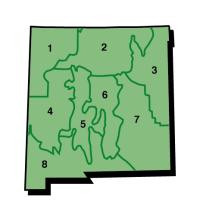New Mexico, the fifth-largest state in the United States, presents a diverse landscape across its 121,412 square miles. From high plateaus and mesas to mountain ranges, canyons, and valleys, the topography significantly influences the Weather In New Mexico. Located primarily between latitudes 32° and 37° and longitudes 103° and 109° W, the average elevation of the state sits around 4,700 feet above sea level, ranging from 2,817 feet at the Red Bluff Reservoir to 13,161 feet at Wheeler Peak. This unique geography, combined with its distance from major bodies of water, shapes New Mexico’s distinct climate.
The state experiences a mild, arid to semiarid continental climate. This translates to low precipitation, abundant sunshine, low relative humidity, and a significant difference between daily high and low temperatures, as well as between summer and winter temperatures. The higher mountain regions exhibit climate characteristics akin to the Rocky Mountains, adding another layer of complexity to the weather in New Mexico.
 Map of New Mexico climate divisions showcasing the state's diverse weather patterns
Map of New Mexico climate divisions showcasing the state's diverse weather patterns
New Mexico can be broadly divided into three major areas by north-south mountain ranges and highlands. These ranges, merging in the north, define the western edge of the Northeastern and Southeastern Plains, which gradually descend eastward and southeastward. East of these mountains, the plains are part of the Arkansas River Basin, primarily drained by the Canadian River and, in the northeast corner, the Cimarron River. The Pecos River originates in the Sangre de Cristo Mountains, flowing south across the Southeastern Plains before joining the Rio Grande in Texas. West of the Continental Divide, which becomes less prominent in southern New Mexico, rivers flow into the Gulf of California via the Colorado River system. Key tributaries include the San Juan River in the north and the Gila River in the south. The Rio Grande Valley lies between the Northern Mountains, the Central Highland system, and the Continental Divide, widening as it extends southward. Southern New Mexico also contains the closed Tularosa Basin within the Central Valley. These varied geographical features contribute to the eight distinct climate divisions within the state, each experiencing unique weather in New Mexico.
Temperature Variations Across New Mexico
Temperature in New Mexico is heavily influenced by elevation rather than latitude. Mean annual temperatures can range dramatically, from a warm 64°F in the southeastern plains (Division 1) to a chilly 40°F or lower in the high northern mountains and valleys (Division 2). For every 1,000-foot increase in elevation, the mean annual temperature can drop by approximately 3°F. This elevation effect is more significant than latitudinal position when considering the weather in New Mexico.
Summer days in New Mexico, particularly below 5,000 feet elevation (Division 8), often see temperatures exceeding 100°F. However, the average monthly maximum temperature in July, the hottest month, ranges from just above 90°F at lower elevations to the upper 70s in higher areas. Interestingly, the hottest days often occur in June, before the monsoon season begins in July and August. Afternoon thunderstorms during these months tend to reduce solar heat, preventing temperatures from reaching their highest potential daily peaks. New Mexico’s record high temperatures are 116°F, recorded at Orogrande in 1934 and Artesia in 1918. Despite the summer heat, clear skies and low humidity allow for significant radiative cooling after sunset, leading to comfortable summer nights. The typical daily temperature range in summer spans 25° to 35°F, a key aspect of the weather in New Mexico.
January, the coldest month, sees average daytime temperatures ranging from the mid-50s in the southern and central valleys to the mid-30s in the higher northern elevations. While freezing temperatures are common statewide during winter, sub-zero temperatures are infrequent outside of the mountains. The record low temperature in New Mexico is -50°F, recorded at Gavilan in 1951. The growing season, or freeze-free season, varies considerably, lasting over 200 days in the southern valleys but less than 80 days in the northern mountains, with some high-altitude valleys experiencing frosts even in summer months, demonstrating the diverse weather in New Mexico.
Precipitation: Aridity and Thunderstorms
New Mexico is characterized by its arid and semiarid climate, reflected in its precipitation patterns. Average annual precipitation varies greatly, from less than 10 inches across much of the southern desert and the Rio Grande and San Juan Valleys to over 20 inches in the higher elevations. This variability is typical of such climates, as seen in Carlsbad’s historical annual extremes of 2.95 and 33.94 inches. The state-wide average rainfall, while less meaningful due to regional variations, is around 13.9 inches. Understanding these variations is crucial when considering the weather in New Mexico.
Summer rainfall primarily comes from short, intense thunderstorms. Moisture from the Gulf of Mexico, drawn into the state by southeasterly winds, combines with strong surface heating and orographic lift as air rises over terrain, leading to condensation and storms. July and August are the wettest months for most of New Mexico, accounting for 30 to 40 percent of the annual precipitation. The San Juan Valley receives less summer monsoon influence, with only about 25 percent of its annual rainfall during these months. From May to October, the warmer half of the year, precipitation ranges from 60 percent of the annual total in the Northwestern Plateau to 80 percent in the eastern plains, highlighting regional differences in weather in New Mexico.
Winter precipitation is mainly driven by frontal systems associated with Pacific storms moving eastward across the country. As these storms move inland, much of their moisture is released over the mountain ranges of California, Nevada, Arizona, and Utah. The remaining moisture falls on the western slopes of the Continental Divide and the northern and central mountain ranges. Winter is generally the driest season in New Mexico, except for areas west of the Continental Divide, particularly noticeable in the Central Valley and on the eastern mountain slopes.
Snow is a significant form of winter precipitation, especially in the mountains. Annual snowfall ranges from about 3 inches in the Southern Desert and Southeastern Plains to over 100 inches in the Northern Mountains. The highest northern mountains can receive over 300 inches of snow annually, showcasing the dramatic variation in weather in New Mexico.
Weather Hazards: Floods and Storms
While general floods are not widespread in New Mexico, localized flash floods are a risk, especially during the summer thunderstorm season. Heavy rains over short periods, combined with the state’s rugged terrain and sparse vegetation, can lead to rapid runoffs and flash flooding in normally dry arroyos. These floods can disrupt traffic, damage infrastructure, and cause property damage in urban areas. Snowmelt in spring (April to June) and heavy general rains in late summer and early fall (August to October) can also cause larger rivers to flood. However, due to the state’s relatively low population density and industrialization, flood damage has generally been limited, despite substantial river level rises during past flood events. These potential hazards are important considerations regarding the weather in New Mexico.
Severe storms, including tropical storms and tornadoes, are relatively infrequent but can occur. Tropical hurricanes from the Gulf of Mexico may occasionally bring heavy rain to eastern and central New Mexico, but significant wind damage from these storms is rare. Similarly, tropical storms from the Gulf of California may bring heavy rain to southwestern New Mexico.
Tornadoes are most likely between May and August, typically in the afternoon or early evening. New Mexico averages about nine tornadoes per year, but they often occur over sparsely populated areas, limiting damage. The most severe tornado in state history struck Wagon Mound in 1930, causing fatalities, injuries, and significant property damage. Thunderstorms are common in summer, ranging from about 40 per year in the south to over 70 in the northeast, which has one of the highest thunderstorm frequencies in the US. Hail can accompany these thunderstorms, particularly near Los Alamos and eastward, posing a threat to agriculture and demonstrating another aspect of the sometimes severe weather in New Mexico.
Sunshine, Humidity, Wind, and Evaporation
New Mexico is known as the “Land of Sunshine,” and for good reason. The state enjoys plentiful sunshine, receiving 75 to 80 percent of possible sunshine hours annually. Winter sunshine is particularly notable, with 70 to 75 percent of possible sunshine. November and spring months can see as much as 90 percent sunshine. Annual sunshine hours range from around 3,700 in the southwest to 2,800 in north-central areas, making sunshine a defining feature of the weather in New Mexico.
Relative humidity in New Mexico is generally low, especially in the valleys, with higher humidity in the cooler mountains. Average relative humidity ranges from about 65 percent at sunrise to around 30 percent in midafternoon. Afternoon humidity in warmer months often drops below 20 percent and can occasionally reach as low as 4 percent. This low humidity mitigates the effects of both summer heat and winter cold, making the weather in New Mexico more comfortable than temperatures alone might suggest.
Wind speeds across New Mexico are typically moderate. Stronger winds can occur with frontal systems in late winter and spring, and before thunderstorms. Frontal winds can exceed 30 mph for hours, with gusts over 50 mph. Spring is the windiest season, and blowing dust and soil erosion can be issues in dry periods, particularly in the eastern plains, which are windier than other parts of the state. Summer winds are predominantly from the southeast, while winter winds are from the west, although local topography can significantly alter wind direction, another factor in local weather in New Mexico.
Potential evaporation in New Mexico far exceeds average annual precipitation, highlighting the aridity of the climate. Evaporation from a Class A pan ranges from about 56 inches in the north-central mountains to over 110 inches in southeastern valleys. During the warm months (May to October), evaporation ranges from around 41 inches in the north-central to 73 inches in the southeast. This high evaporation rate is a critical characteristic of the weather in New Mexico, influencing water resources and agriculture.
Drought Conditions in New Mexico
New Mexico has experienced several periods of drought. Severe meteorological drought, as defined by the Palmer Drought Index, has occurred in the mid-1930s, 1940s, 1950s, 1960s, and most notably from 2000 to 2004. The longest general drought since 1930 was in the 1950s. Hydrological drought, measured by the Surface Water Supply Index (SWSI), can persist even after meteorological drought indices improve, as seen in 2004. Monitoring drought conditions is essential for managing water resources and understanding long-term weather in New Mexico patterns.
Recreation, Health, and Economy Influenced by Climate
New Mexico’s climate significantly contributes to its recreation and health appeal. Vast wilderness areas, numerous campgrounds within over 8 million acres of forestland, National Monuments, State Parks, and Carlsbad Caverns National Park attract outdoor enthusiasts. Hunting, fishing, boating, and winter skiing in mountain areas are popular activities. The generally mild, dry, and sunny climate makes New Mexico a desirable destination for recreation and for individuals seeking a healthy environment. These aspects of the weather in New Mexico are key drivers for tourism.
The economy of New Mexico, particularly agriculture and recreation, is heavily influenced by climate. Agriculture, including farming and livestock raising, is adapted to the arid and semiarid conditions. While less than 4 percent of the state is cultivated, with about one-third irrigated, irrigation is crucial, especially in southern valleys and other key agricultural areas. Livestock grazing is extensive, benefiting from generally sufficient forage growth and the mild climate that allows year-round open range grazing. Dryland farming in the eastern plains relies on seasonal moisture. Stored surface water, essential for irrigating crops like cotton, truck crops, fruits, and nuts, depends on winter snowpack in the mountains. Thus, the weather in New Mexico directly shapes agricultural practices and economic opportunities.
In conclusion, the weather in New Mexico is characterized by diverse conditions shaped by its unique geography and climate divisions. From sunshine and temperature variations to precipitation patterns and weather hazards, understanding these elements provides a comprehensive view of what to expect in the Land of Enchantment.
Source: WRCC

